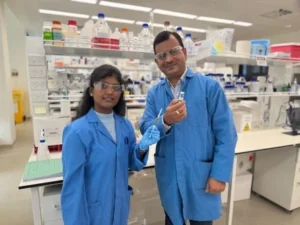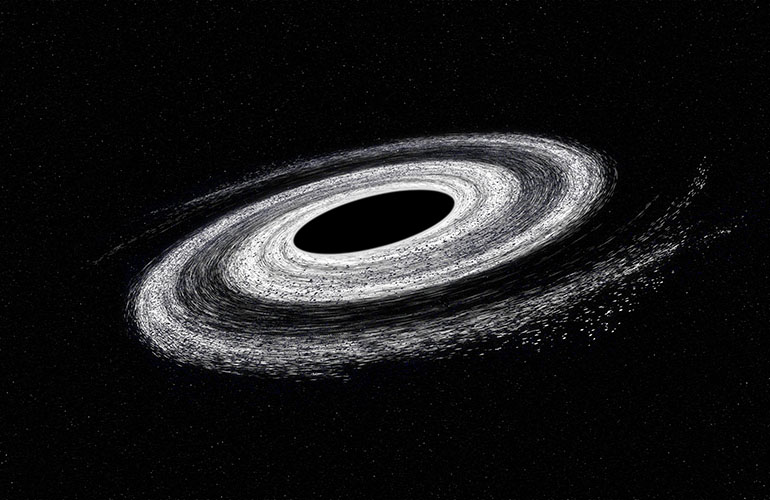This week in R&D, we’re watching emerging technologies for how we secure critical assets, treat chronic disease and discover novel materials. Highlights include a new self-driving lab that accelerates materials discovery tenfold and a collaboration between the British and French governments to protect GPS from jamming. In the AI space, Mira Murati, a former OpenAI exec now at the helm of Thinking Machines, has overseen a fundraise that has the startup worth $12 billion.
Aerospace and defense technology
1. Sandia team designs and builds deployable high-security vault in six months
The story: Sandia National Laboratories engineers designed and built a high-security vault within a standard 20-ft shipping container. The team adopted a rapid, iterative design process rooted in design-thinking, ditching strict specs for flexible goals like maxing out performance within the container’s size and weight limits.
The numbers:
- 6 months from concept to full demonstration
- 20-foot standard shipping container size
- Under $500 for initial 1:14-scale model
Why it matters: To fill a capability gap for securing national security assets where permanent facilities are unavailable. The development could provide an alternative for securing nuclear weapons and materials from theft, sabotage and unauthorized access.
Watch for: Sandia expects the vaults to see wider use.
Health & Medicine:
2. Weekly injection could boost Parkinson’s patients’ quality of life

UniSA researchers Deepa Nakmode and Professor Sanjay Garg are focusing on developing the new injectable drug for Parkinson’s patients. [University of South Australia]
The story: Scientists from the University of South Australia have developed a long-acting injectable formulation that delivers a steady dose of levodopa and carbidopa, two key Parkinson’s medications, over a week. The biodegradable formulation is injected under the skin or into muscle tissue, where it gradually releases the medication.
The numbers:
- More than 8.5 million people worldwide affected by Parkinson’s disease
- More than 90% of the levodopa dose and more than 81% of the carbidopa dose released over seven days
- The implant degraded by over 80% within a week
- Can be administered through a fine 22-gauge needle
Why it matters: “Our goal was to create a formulation that simplifies treatment, improves patient compliance, and maintains consistent therapeutic levels of medication. This weekly injection could be a game-changer for Parkinson’s care,” says Prof Garg. The frequent dosing of current oral medications is a burden, especially for the elderly and infirm.
Watch for: UniSA scientists hope to start clinical trials in the near future and are exploring commercialization opportunities.
Chemistry:
3. Gut microbes may flush ‘forever chemicals’ from the body

Magnifying glass over articles discussing health risks of PFAS chemicals in water.
The story: Some human gut microbes can absorb PFAS, toxic “forever chemicals” that are found in common waterproof or stain-resistant household items, including nonstick cookware, based on research in mice.
The numbers:
- Microbes amassed 20-75% of the PFAS chemicals they were exposed to with no negative effects
- Mice exposed to forever chemicals had concentrations of PFAS in their fecal matter
Why it matters: Mice colonized with 20 human gut bacterial strains had more PFAS in their feces than microbe-free mice, suggesting that human gut bacteria can remove PFAS from the body. PFAS are linked to health issues including high cholesterol, developmental delays and certain cancers.
Watch for: Future studies investigating gut microbiomes and PFAS. There is also a possibility to create a probiotic containing the PFAS-absorbing bacteria.
General technology:
4. British and French governments to collaborate on securing GPS for critical infrastructure

Space satellite orbiting the Earth. 3d rendering
The story: British and French technology experts will soon be working together to make GPS and other similar technologies more resistant to disruptions as GPS jamming has grown more common.
The numbers:
- 63 UK military aircraft completed 1,467 flights over Eastern Europe and the Middle East (first 4 months of 2024). In that time period, “Russia jammed the GPS signal on every fourth flight of the UK Royal Air Force,” according to the Ukrainian Pravda publication.
- 504 transport and reconnaissance missions over Eastern Europe
- 142 of these missions encountered GPS jamming
- 60 cases experienced multiple jamming efforts
Why it matters: “From our electricity infrastructure, to transport, to financial transactions, the tech we rely on for everyday life depends on reliable Positioning, Navigation and Timing (PNT), often provided via satellites,” the announcement reads. The conflict in Ukraine shows how even small devices, in some cases hand-held, can disrupt GPS communications.
Watch for: Development of e-LORAN, a system that uses ground-based radio towers as a “backup” to GPS. DSIT describes it as being “much more challenging” to block, and as such can keep critical UK infrastructure technology running “even when GPS fails.”
Scientific computing and big data (AI):
5. Mira Murati’s Thinking Machines Lab is worth $12B in seed round
 The story: Thinking Machines Lab, the AI startup founded by OpenAI’s former chief technology officer Mira Murati, officially closed a $2 billion seed round led by Andreessen Horowitz on Monday, according to Tech Crunch. The deal includes participation from Nvidia, Accel, ServiceNow, CISCO, AMD, and Jane Street, valuing the startup at $12 billion.
The story: Thinking Machines Lab, the AI startup founded by OpenAI’s former chief technology officer Mira Murati, officially closed a $2 billion seed round led by Andreessen Horowitz on Monday, according to Tech Crunch. The deal includes participation from Nvidia, Accel, ServiceNow, CISCO, AMD, and Jane Street, valuing the startup at $12 billion.
The numbers:
- The $2 billion seed round is one of the largest in Silicon Valley history
- $12 billion valuation (up from reported $10 billion just a month ago)
- Less than a year old
- Planning to unveil first product in “next couple months”
Why it matters: Thinking Machines Lab is one of a handful of AI startups that investors believe to be a legitimate threat to leading AI model developers today, such as OpenAI, Anthropic and Google DeepMind.
Watch for: The company says its future products will include a “significant open source” offering.
6. This AI-powered lab runs itself and discovers new materials 10x faster
The story: Researchers from North Carolina State University have demonstrated a novel technique that allows “self-driving laboratories” to collect at least 10 times more data than previous techniques at record speed. By switching from steady-state to dynamic flow experiments, the self-driving lab now uses chemical mixtures that are continuously varied through the system and monitored in real time. The research was published in Nature Chemical Engineering.
The numbers:
- At least 10 times more data than previous techniques.
- Data capture every 0.5 seconds vs. waiting up to 1 hour per experiment
- 20 data points in 10 seconds vs. 1 data point previously
- Supported by NSF grants 1940959, 2315996 and 2420490
Why it matters: “Imagine if scientists could discover breakthrough materials for clean energy, new electronics, or sustainable chemicals in days instead of years, using just a fraction of the materials and generating far less waste than the status quo,” said Milad Abolhasani in a news release.
Watch for: Faster breakthroughs in clean energy, electronics, and sustainability applications. “The future of materials discovery is not just about how fast we can go, it’s also about how responsibly we get there,” Abolhasani said in the release. “Our approach means fewer chemicals, less waste, and faster solutions for society’s toughest challenges.”
Space:
7. Astronauts from India, Poland and Hungary are headed back to Earth
The story: Astronauts from India, Poland and Hungary are headed back to Earth after a visit to the ISS on a privately funded SpaceX rocket.
The numbers:
- These are the first astronauts from these countries in over 40 years
- The price was more than $65 million per country
- They launched on June 25 and returned on Monday
- This was Axiom’s fourth flight to the ISS since 2022
Why it matters: Astronauts emphasized the importance of this mission for their countries. “These things are possible even for smaller countries like ours,” Tibor Kapu said. This story is also part of a continuing saga as NASA embraces commercial space flights.
Watch for: Four of the seven current residents of the ISS, all from the U.S. and Russia, will be replaced by a fresh crew in another SpaceX flight in a few weeks, aiming for a launch date of July 31.
8. LIGO catches a 225-solar-mass black-hole
 The story: The LIGO-Virgo-KAGRA (LVK) Collaboration has spotted the merger of the most sizable black holes ever observed with gravitational waves
The story: The LIGO-Virgo-KAGRA (LVK) Collaboration has spotted the merger of the most sizable black holes ever observed with gravitational waves
The numbers:
- 225 solar masses (final black hole mass)
- 100 and 140 solar masses (the two merging black holes)
- Previous record was 140 solar masses (GW190521 in 2021)
- More than 200 black hole mergers observed in fourth run
Why it matters: “This is the most massive black hole binary we’ve observed through gravitational waves, and it presents a real challenge to our understanding of black hole formation,” says Mark Hannam of Cardiff University. “Black holes this massive are forbidden through standard stellar evolution models. One possibility is that the two black holes in this binary formed through earlier mergers of smaller black holes.”
Watch for: “It will take years for the community to fully unravel this intricate signal pattern and all its implications,” says Gregorio Carullo of the University of Birmingham. The calibrated data will be made available through the Gravitational Wave Open Science Center (GWOSC) for other researchers to analyze, with additional observations from the first half of the run to be published later in summer.
